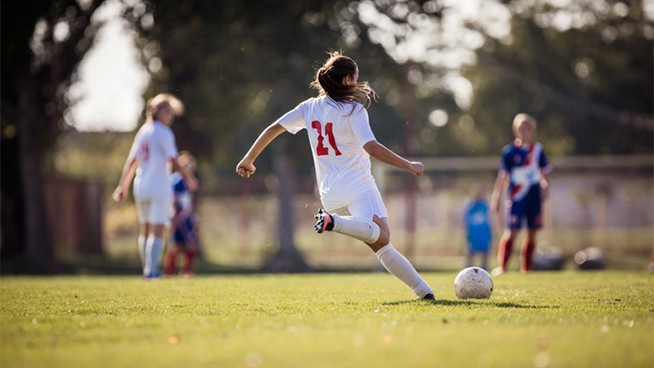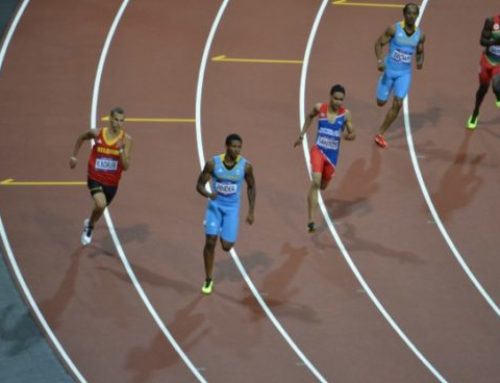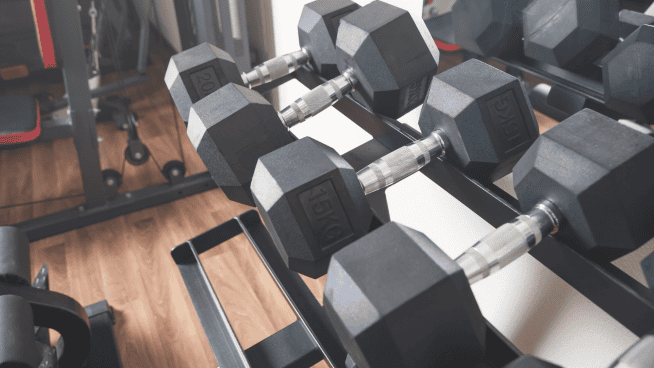Lengthen Your Stride for Maximum Speed
Track season is fast approaching, meaning it’s time to train for maximum speed. But just focusing on stride frequency and length oversimplifies things. Both are complex operations commonly misunderstood by the average athlete.
There are two key factors in developing and maintaining maximum velocity in acceleration. One is relative body strength and power. This goes back to Newton’s Third Law, “For every action there is an equal and opposite reaction.” The more posterior force you produce into the ground, relative to your body weight, the faster you will go forward.
The other factor, and the one we’re going to focus on here, is hip flexibility and mobility. Maximum strength does not equal maximum speed unless you can reach a full range of motion or triple extension (hip, knee, ankle) in your stride. This is where hip separation—or the ability to fully extend one leg at the hip while simultaneously reaching full flexion with the other—creates huge strides and maximum speed and raises the potential of force generated during the drive phase.
RELATED: The Science of the 100-Meter Dash (and How To Get Faster)
Hip Separation Exercises
Try the following exercises during your warm-up and workout plan to improve your hip separation.
Pulsed Hip Flexor
This is a simple yet effective warm-up stretch I encourage all athletes to perform.
- Begin in a half-kneeling position with correct posture and pelvic tilt, making sure both legs create 90-degree angles.
- Maintaining correct posture and core stability, push forward on the front leg while keeping the front foot flat. This should stretch the hip flexor on the rear leg.
- Push to a full range of motion; hold for 2-3 seconds.
- Return to the starting position.
- Repeat this stretch five times on each leg, making sure to progressively increase your range of motion.
Cook Hip Lift
This might be the best stretch for maximum speed you’re not doing.
- Lie on your back with one knee bent and that foot flat on the ground.
- Hug your other knee to your chest to stretch your glutes.
- From this beginning position, drive through the heel of your ground foot and push your hips as high as possible, while continuing to hug your opposite knee. This creates great hip separation, stretches important muscles groups and activates the glutes, hips and core.
- Repeat for 5-8 reps on each side.
Wall Drive Drill
The Wall Drive is a classic drill used to reinforce acceleration and drive phase mechanics for maximum speed. However, it is often abused or performed improperly. Attention to detail in this drill can yield incredible results.
- Lean on a wall, railing or other fixed surface at a diagonal angle. The body should maintain a straight posture from head to heel.
- Raise one knee forward and keep the shin parallel to the body.
- Explosively switch legs, driving the front leg back while simultaneously driving the rear leg forward.
The Wall Drive Drill itself is fairly simple and straightforward, but attention to detail will improve hip separation and create longer strides. In the flexed position, pay special attention to the rear leg. As the front leg drives forward, the rear leg has to maintain a fully extended position to simulate a complete stride. This requires a strong core and loose hip flexors. If your rear leg is not fully extended, there is still room for improvement. I recommend slowing the drill down and perfecting the technique, then working at higher speeds while maintaining great form. In the video above, Michael Johnson demonstrates how to master the sprint drive technique with The Chinese Hip Flexor Drill.
Perform this drill after a dynamic warm-up and prior to sprints for the day. I would begin with 2-3 sets of 10 switches, focusing on form and full extension, then progress to 2-3 sets of faster, more powerful movements. After working on this drill, practice applying hip separation with short sprints that focus on acceleration, such as 10-Yard Sprints or Flying 30s.
Sled Pulls
Finally, we want to apply the principle of hip separation to our strength training workouts. For sprinters, Sled Pulls are an excellent exercise to develop strength that translates directly to training goals. However, as with the Wall Drive Drill, attention to detail is required to create the best results. Check out the video above for an example of Sled Pulls.
When working the Sled Pull, you should focus on a few distinct things. First, body positioning is crucial; you should maintain a straight posture at a diagonal angle throughout the pull. Second, foot placement should mimic correct sprinting technique, with the foot landing directly under the hips and driving through the balls of the feet. Finally, the key to improving stride length is training full extension and knee drive. Every step in the Sled Pull should drive through a complete range of motion to triple extension of the hip, knee and ankle, while simultaneously driving the other knee forward. By training with correct form in this exercise, you will ingrain correct movement patterns into your nervous system and memory. This will translate to improved results and maximum speed when it counts!
RELATED: STACK Fitness Weekly: Build Full-Body Strength With Sled Pulls
Knee to Chest/Reclining Big Toe (as a cool-down)
After the workout, it is important to continue to work on hip separation and flexibility during your cool-down. A great cool-down stretch is a three-step sequence to work both hip separation and flexibility in the glutes and hamstrings. Check out the video playlist above for a demonstration of Reclining Big Toe.
- Begin on your back with one leg completely straight.
- Pull the other knee to your chest with your hands behind your knee.
- After 30 seconds, straighten the leg and point the toes down.
- After holding that position for 30 seconds, return to the initial stretch for another 30 seconds and stretch through an even greater range of motion. Do this at a minimum once on each side using 30-second intervals, preferably 60-second intervals, for two sets to maximize range of motion.
Sample Workout for Hip Separation and Speed
Below is a sample workout utilizing some of the components discussed earlier, so you can see how to best implement these exercises into your program.
1. Initial calisthenics to elevate the heart rate
2. Dynamic stretching
Examples: Pulsed Hip Flexor and Cook Hip Lifts
3. Running progressions to activate the central nervous system
4. Form breakdown
Example: Wall Drive Drill
5. Sprints, emphasizing the drive phase
6. Cool-down stretching
Implement Sled Pulls on strength training days
[cf]skyword_tracking_tag[/cf]RECOMMENDED FOR YOU
MOST POPULAR
Lengthen Your Stride for Maximum Speed
Track season is fast approaching, meaning it’s time to train for maximum speed. But just focusing on stride frequency and length oversimplifies things. Both are complex operations commonly misunderstood by the average athlete.
There are two key factors in developing and maintaining maximum velocity in acceleration. One is relative body strength and power. This goes back to Newton’s Third Law, “For every action there is an equal and opposite reaction.” The more posterior force you produce into the ground, relative to your body weight, the faster you will go forward.
The other factor, and the one we’re going to focus on here, is hip flexibility and mobility. Maximum strength does not equal maximum speed unless you can reach a full range of motion or triple extension (hip, knee, ankle) in your stride. This is where hip separation—or the ability to fully extend one leg at the hip while simultaneously reaching full flexion with the other—creates huge strides and maximum speed and raises the potential of force generated during the drive phase.
RELATED: The Science of the 100-Meter Dash (and How To Get Faster)
Hip Separation Exercises
Try the following exercises during your warm-up and workout plan to improve your hip separation.
Pulsed Hip Flexor
This is a simple yet effective warm-up stretch I encourage all athletes to perform.
- Begin in a half-kneeling position with correct posture and pelvic tilt, making sure both legs create 90-degree angles.
- Maintaining correct posture and core stability, push forward on the front leg while keeping the front foot flat. This should stretch the hip flexor on the rear leg.
- Push to a full range of motion; hold for 2-3 seconds.
- Return to the starting position.
- Repeat this stretch five times on each leg, making sure to progressively increase your range of motion.
Cook Hip Lift
This might be the best stretch for maximum speed you’re not doing.
- Lie on your back with one knee bent and that foot flat on the ground.
- Hug your other knee to your chest to stretch your glutes.
- From this beginning position, drive through the heel of your ground foot and push your hips as high as possible, while continuing to hug your opposite knee. This creates great hip separation, stretches important muscles groups and activates the glutes, hips and core.
- Repeat for 5-8 reps on each side.
Wall Drive Drill
The Wall Drive is a classic drill used to reinforce acceleration and drive phase mechanics for maximum speed. However, it is often abused or performed improperly. Attention to detail in this drill can yield incredible results.
- Lean on a wall, railing or other fixed surface at a diagonal angle. The body should maintain a straight posture from head to heel.
- Raise one knee forward and keep the shin parallel to the body.
- Explosively switch legs, driving the front leg back while simultaneously driving the rear leg forward.
The Wall Drive Drill itself is fairly simple and straightforward, but attention to detail will improve hip separation and create longer strides. In the flexed position, pay special attention to the rear leg. As the front leg drives forward, the rear leg has to maintain a fully extended position to simulate a complete stride. This requires a strong core and loose hip flexors. If your rear leg is not fully extended, there is still room for improvement. I recommend slowing the drill down and perfecting the technique, then working at higher speeds while maintaining great form. In the video above, Michael Johnson demonstrates how to master the sprint drive technique with The Chinese Hip Flexor Drill.
Perform this drill after a dynamic warm-up and prior to sprints for the day. I would begin with 2-3 sets of 10 switches, focusing on form and full extension, then progress to 2-3 sets of faster, more powerful movements. After working on this drill, practice applying hip separation with short sprints that focus on acceleration, such as 10-Yard Sprints or Flying 30s.
Sled Pulls
Finally, we want to apply the principle of hip separation to our strength training workouts. For sprinters, Sled Pulls are an excellent exercise to develop strength that translates directly to training goals. However, as with the Wall Drive Drill, attention to detail is required to create the best results. Check out the video above for an example of Sled Pulls.
When working the Sled Pull, you should focus on a few distinct things. First, body positioning is crucial; you should maintain a straight posture at a diagonal angle throughout the pull. Second, foot placement should mimic correct sprinting technique, with the foot landing directly under the hips and driving through the balls of the feet. Finally, the key to improving stride length is training full extension and knee drive. Every step in the Sled Pull should drive through a complete range of motion to triple extension of the hip, knee and ankle, while simultaneously driving the other knee forward. By training with correct form in this exercise, you will ingrain correct movement patterns into your nervous system and memory. This will translate to improved results and maximum speed when it counts!
RELATED: STACK Fitness Weekly: Build Full-Body Strength With Sled Pulls
Knee to Chest/Reclining Big Toe (as a cool-down)
After the workout, it is important to continue to work on hip separation and flexibility during your cool-down. A great cool-down stretch is a three-step sequence to work both hip separation and flexibility in the glutes and hamstrings. Check out the video playlist above for a demonstration of Reclining Big Toe.
- Begin on your back with one leg completely straight.
- Pull the other knee to your chest with your hands behind your knee.
- After 30 seconds, straighten the leg and point the toes down.
- After holding that position for 30 seconds, return to the initial stretch for another 30 seconds and stretch through an even greater range of motion. Do this at a minimum once on each side using 30-second intervals, preferably 60-second intervals, for two sets to maximize range of motion.
Sample Workout for Hip Separation and Speed
Below is a sample workout utilizing some of the components discussed earlier, so you can see how to best implement these exercises into your program.
1. Initial calisthenics to elevate the heart rate
2. Dynamic stretching
Examples: Pulsed Hip Flexor and Cook Hip Lifts
3. Running progressions to activate the central nervous system
4. Form breakdown
Example: Wall Drive Drill
5. Sprints, emphasizing the drive phase
6. Cool-down stretching
Implement Sled Pulls on strength training days
[cf]skyword_tracking_tag[/cf]










